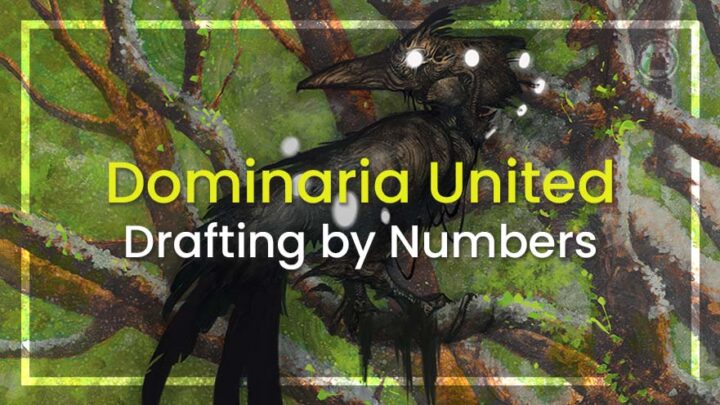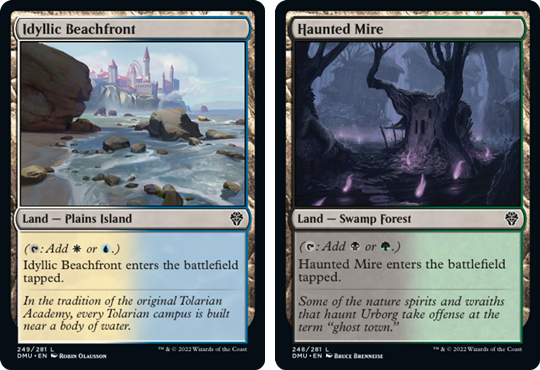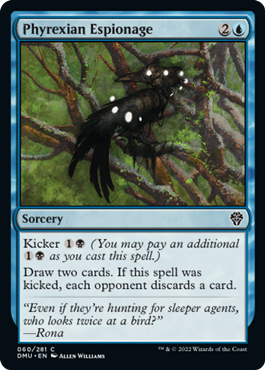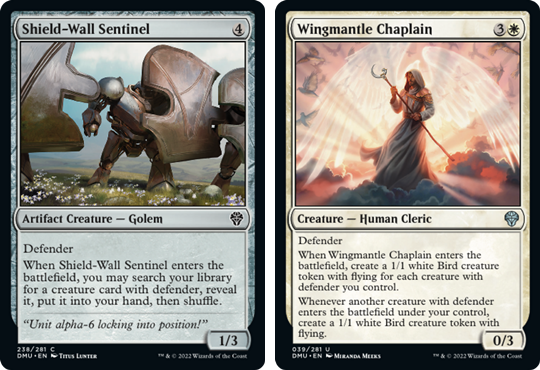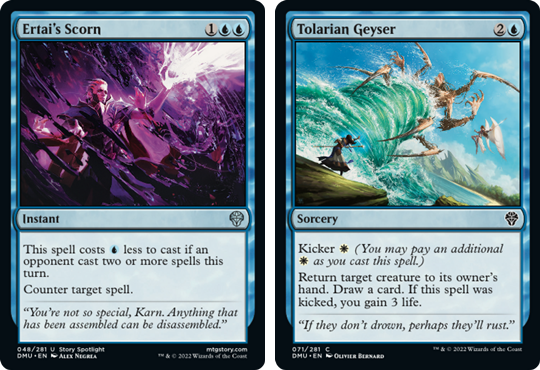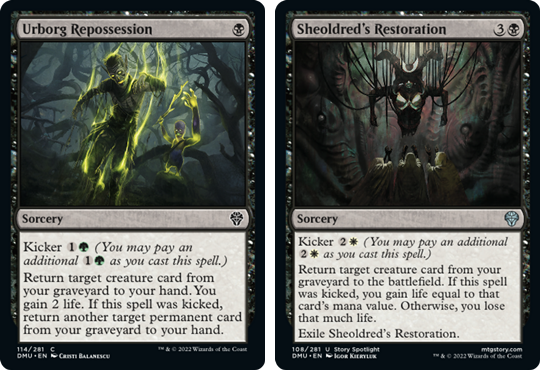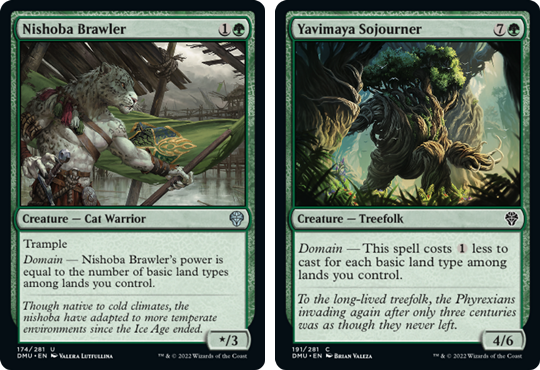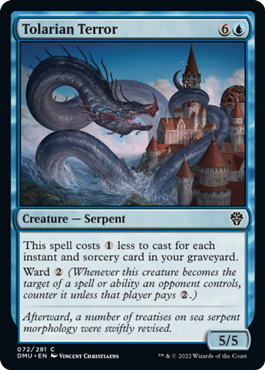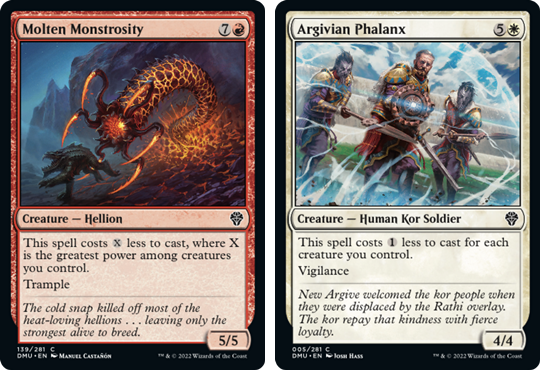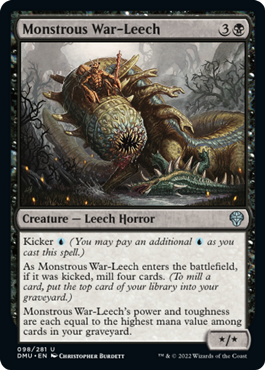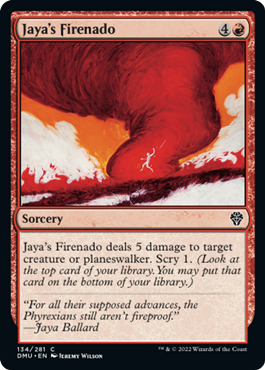Welcome back to the second, more scientific section of our Dominaria United draft guide!
With a bit more time and a lot more data under our belts since the format’s release, Limited players can now supplement natural intuition and personal judgment with statistical insights on how to consistently find a winning deck. Using large online datasets for this sort of thing helps to cut through the inherent variance and bias we experience in our games, and makes you a better drafter.
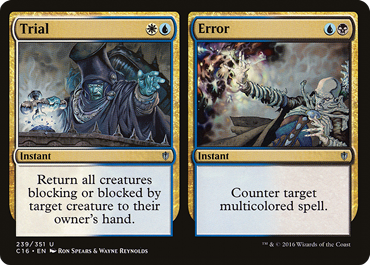
And as much as it pays homage to the fundamentals of Magic, there has definitely been a learning curve to Dominaria United. Much like Streets of New Capenna turned out, this is a set where multicolored decks seem core to its identity, but the actual number of colors to play (and your level of commitment to said colors) is more complicated than it first appears.
It’s also another set where lands are heavily emphasized as both fixing and mechanical enabler, thanks to domain and off-color kicker costs appearing frequently in all colors.
How many of these lands do you need? How soon should you take them? Are the multicolor effects good enough to justify the effort? And will you even have time to set them up before this format’s aggro decks run you over??
These are the kinds of questions that send me reaching for a community database like 17Lands to provide a more definitive answer than just “vibes.” So, let’s take a look at the numbers together:
HOW FAST IS THE FORMAT?
The short answer? It’s pretty slow. Maybe not quite as slow as the last Dominaria format, but it’s close. Another way to ask this question is to ask which resource you tend to run short on more: cards or mana? How often do you die with castable spells in hand, and how often do you get ground down by an opponent answering everything you’ve got? In my experience of DMU, the latter is far more common — and the win-rate data of individual cards backs that up.
This table is sorted by Impact-When-Drawn (IWD), which shows how the win rate of decks which included that card improved (or declined) in games where they drew the card vs. games where they didn’t. It’s as good a single-number representation of value as we can easily extract for most cards. And among DMU’s highest IWD commons, 14 of 15 are either removal or card advantage tools like Shield-Wall Sentinel, Phyrexian Espionage and Vineshaper Prodigy.
You always expect removal and two-for-ones to be high on these charts, but there’s usually a Jewel Thief or two representing the best common combat creatures. Not so for DMU, though! There’s also an emphasis on unconditional ability to remove large creatures as opposed to damage based removal which might be more mana efficient. Lightning Strike doesn’t crack the top 15, but Tolarian Geyser and Destroy Evil do.
This all seems to indicate that DMU is a format where big, expensive creatures are good enough to dominate combat, and games are slow enough that out-grinding them with removal is more profitable than trying to get under them. That even the best large creatures are themselves left off this list shows that none of them are that much better than any others. It’s a volume game, so card advantage (and the harder-to-replace removal spells) have the highest win rate.
These trends remain even when you narrow the data to look at specific color pairs. Whether you’re buying time to cast big creatures as the slower deck, trying to get under big creatures as the faster deck, or trying to outgun your opponent in the big creature mirror, removal (and overall card advantage) matters.
The only exception is the ultra-fast red/white archetype, which primarily wants to overwhelm opponents as soon as possible. Yet, success there has far more to do with powerful uncommon or rare creatures and a solid curve than wanting a different set of foundational common spells.
WHICH CARDS ARE OVER/UNDER-RATED?
All the above may not sound like much of a hot take, and it’s true that this set doesn’t really have that many subtle traps or sleeper hits. Other than people initially underrating the defender synergy package, the correlation between win-rate-when-drawn and average-last-seen-at (i.e. how quickly on average a card is drafted from its pack) is pretty tight.
The size of the dots correspond to the actual sample size of picks for that card; the small underperforming dots off to the left are all random rares/mythics. Meanwhile the few, really obvious overperforming dots on the right are the aforementioned defender cards, with Shield-Wall Sentinel and Wingmantle Chaplain still enjoying disproportionate success.
Other outliers which don’t really say much are the multicolor uncommons (which most people aren’t in a position to take by pack two or three) or common tricks like Take Up the Shield, where the first copy is valuable but there tends to be excess supply.
But there are still other valuable trends to look at here. Blue and white cards are generally being undervalued by a couple of picks, especially blue where almost every common is outperforming its pick rate.
The purple dots indicate “multicolor” cards, but this includes those with off-color kicker costs. These kicker cards are mostly outperforming the actual gold uncommons despite being picked lower — especially the more flexible, value-oriented ones.
The common dual-lands are, on average, being taken around the 4th-5th pick mark (the big cluster of purple dots at the center of the graph), so you do need to aggressively spend picks on them if the domain or fixing matters to your deck. The fact they cleave so closely to the dotted line suggests this is roughly where they should be for the value they add. Most trophy decks at Mythic levels seem to play 1-3 in their colors, or 4-6 if they’re trying to reach full domain consistently.
Green is the most contested color, with very few cards slipping lower in the pick order than their results indicate they should. Perhaps this is due to the obvious strength of big cheap bodies? Regardless, it’s something to keep in mind when considering green as a secondary or mid-draft pivot color.
HOW GOOD ARE THE “DISCOUNTED” CURVE-TOPPERS?
Every Limited format has its own subgroup of cards which are tricky to evaluate on face value. For Dominaria United, we have a cycle of powerful-looking creatures at common, each of which can be cast for an extremely good rate of mana depending on how far you go in fulfilling their conditions. Can the data help us understand which of these cards are worth taking, and when?
Of course it can.
Looking to IWD, we see that Tolarian Terror is the clear standout, with Yavimaya Sojourner close behind. As the most easily discounted members of the cycle, and the ones appearing in slow/ramp-happy colors, this seems to make a lot of sense. Another good one-glance metric for commons is Average-Taken-At (ATA), showing how much players prioritize the card in their pick order. Terror has consistently been taken 2-4 picks higher than the rest of the cycle, showing that players see it as a key pillar of their strategy.
Blue decks have both the time and inclination to fill their yard, and unlike the red or white commons (which aren’t good when behind) or the green and black ones (which are hard to aggressively earn the discount on), Terror will very often be cheap enough to be cast as part of a double spell turn as soon as you draw it, helping these decks cement a late game advantage and convert card advantage to board advantage in a timely fashion.
Again, these evaluations might sound shallow and simple to intuit, even without looking at the data. But if we want a deeper understanding of this cycle, we can see a great example of how the interplay between IWD, OH WR and GD WR is often more informative than using any one stat alone.
Molten Monstrosity and Argivian Phalanx look like the big losers of the cycle going by IWD — the metric I most often use for quick reference. However, the GD WR for Phalanx has it basically on par with Necromass and Sojourner. It’s just that decks with Phalanx have significantly higher overall win rates than any of the others, so IWD is holding it to a higher standard.
But does that still indicate the card is overrated? That seems like a reasonable take. Given you need to first build a wide board to cast Phalanx for a reasonable cost, it’s practically the definition of a win-more card. However, it also has the highest opening-hand winrate of the cycle and by FAR the smallest falloff in WR between games where it’s in the opening hand vs. being drawn later on, where it’s presumably easier to cast.
Judging by these stats, Terror is still the only one worth picking aggressively and in multiples; it’s irreplaceable in spell-heavy blue decks. Phalanx and Sojourner are more sidegrades for the decks they fit into, but are absolutely worth a slot without much adjustment.
Meanwhile Necromass and Monstrosity are significantly less good — perhaps because they often are competing against the other members of the cycle, but moreso because they are significantly less reliable in how their discount functions.
As a final note here, I wanted to check out the stats on Monstrous War-Leech. While it doesn’t actually get its own cost discounted, the obvious synergy with the inflated casting costs of these commons makes it the honorary 6th card of the cycle for me. In general, the War-Leech is having average performance for an uncommon — better than most common creatures but definitely not a game-winner in its own right.
This remains true when we filter the results to just green/black or blue/black decks (the two colors I’ve most commonly tried to pair it with), but it hugely overperforms in red/black! Why does it do so well here? Is it simply the lacking availability of big bodies compared to other color combinations? The high performance of expensive red commons like Jaya’s Firenado and Meria’s Outrider?
It is worth noting that Molten Monstrosity, while still not a great card, also sees its winrate improve in red/black decks. Perhaps just combining these with Firenado, Aggressive Sabotage and Extinguish the Light is the optimal way to play this lane?
WHAT DO WINNING DECKS IN THE FORMAT LOOK LIKE?
Speaking of optimal ways to play a color pair, one of the most valuable features on 17lands is the one which is the hardest to express in clear-cut statistics. The “Recent Trophy Decks” gallery can really help visualize how the individual statistical trends suggested by the rest of the site come together into coherent, winning drafts.
I most often use them to understand what kind of curve I should be playing for a particular archetype, as well as to spot the kind of crucial “signpost common” which forms the backbone of every winning deck.
These are the cards where, in that color, you’ll happily play the third and fourth and fifth copies — and, therefore, the ones which can help direct you into an open lane by how frequently and how late they’re available. There seem to be more winning decks playing such commons in large multiples for DMU than other recent formats, so it makes sense to take this chance to highlight this tool.
I’ve collected a small gallery of Mythic 7-x drafts, showing how different color pairs win with few or no bomb rares. But I’ll also offer a rough summary of my findings on which of these cards you can look to as your reliable workhorses (in rough order of priority).
WHITE: Argivian Cavalier, Captain’s Call, Destroy Evil, Clockwork Drawbridge¹
BLUE: Phyrexian Espionage, Essence Scatter, Tolarian Geyser, Tolarian Terror
BLACK: Tribute to Urborg, Splatter Goblin, Eerie Soultender, Phyrexian Rager, Shadow Prophecy
RED: Lightning Strike, Flowstone Infusion, Flowstone Kavu, Keldon Strike Team, Coalition Warbrute/Meria’s Outrider²
GREEN: Colossal Growth/Gaea’s Might², Magnigoth Sentry, Sunbathing Rootwalla, Vineshaper Prodigy
¹ Don’t prioritize this one if you’re in red/white.
² The second option is better for decks capable of high domain counts.
End Step
With all that said, you should now have all the knowledge you need to master Dominaria United draft! Enjoy the format while it lasts and be sure to share all your best lists with me on Twitter.

Tom’s fate was sealed in 7th grade when his friend lent him a pile of commons to play Magic. He quickly picked up Boros and Orzhov decks in Ravnica block and has remained a staunch white magician ever since. A fan of all Constructed formats, he enjoys studying the history of the tournament meta. He specializes in midrange decks, especially Death & Taxes and Martyr Proc. One day, he swears he will win an MCQ with Evershrike. Ask him how at @AWanderingBard, or watch him stream Magic at twitch.tv/TheWanderingBard.

